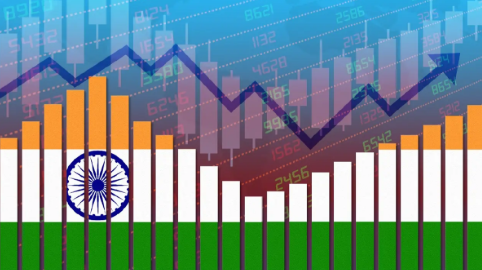There was a time when India was the economic heart of the world.
For much of recorded history, India wasn’t just a country, it was the world’s largest economy. In 1 CE, India commanded over one-third of global GDP. This is the untold story of how it fell, and how it’s rising again.
Sone Ki Chidiya: The Rise of the Golden Bird
India’s cities were vibrant trade hubs, its artisans world-renowned, and its wealth unmatched. Historians and economists alike agree. India was the center of global commerce. For over 1,500 years, India remained either the largest or second-largest economy, rivalled only by China. Whether it was Pataliputra’s learning, Ujjain’s astronomy, or Mughal Delhi’s industry, India defined economic power, supported by innovation, education, and trade.
This was the era when India was known as “Sone Ki Chidiya”, the Golden Bird.
According to historical estimates (Angus Maddison, IMF, GoI):
- From 1 AD to 1000 AD (approx.), India held 30–35% of global GDP.
- By 1500 AD, India still contributed around 25% of global output.
- At 1700 AD, on the eve of British colonial incursions, India’s share remained high at nearly 24%.

Meanwhile, India (in orange) and China (in red) together accounted for more than half of the world’s economy during this period, as clearly shown in long-term GDP share visualizations.
The Fall of the Golden Bird
India’s economic decline began in the 18th century, closely tied to the expansion of British colonial rule. The Battle of Plassey in 1757 was a turning point, it marked the start of systematic control by the British East India Company, which over the next two centuries dismantled India’s globally integrated economy.
At the beginning of this period, in 1700, India contributed an estimated 24.4% of global GDP, as per Angus Maddison’s historical estimates. But by 1900, this share had collapsed to less than 5%, and by 1950, it stood at just 4.2%. This represents a dramatic fall in India’s global economic standing, not due to natural decline, but through deliberate colonial policy.
The British Raj implemented an extractive economic system that drained India’s resources while preventing industrial growth:
India’s once-flourishing textile industry was gutted under British rule, with exports collapsing by over 95% between 1800 and 1900 as colonial policies favored British goods. Economist Utsa Patnaik estimates that $45 trillion was drained from India between 1765 and 1938 through exploitative taxation and trade. Even during famines like the South Indian famine of 1876-78 or Bengal famine of 1943, grain was exported while millions starved, over 60 million Indians perished during colonial-era famines.
By the time India gained independence in 1947, its share of global GDP had declined from 24.4% (1700) to less than 5% by 1900, and further to just 4.2% by 1950. Per capita income had also deteriorated to rank among the lowest globally.
The Return of the Golden Bird
By the late 20th century, India’s economy remained far from its historic prominence. It ranked 12th globally in 1980 and 11th in 1990, constrained by a heavily regulated system and limited global integration. The turning point came in 1991, when a balance of payments crisis led to sweeping economic reforms. The government liberalized trade, reduced tariffs, ended licensing controls, and opened the economy to foreign investment, marking India’s shift from a state-led to a market-driven model.
In the two decades following liberalization, India’s GDP growth averaged over 5.5% in the 1990s and exceeded 7% in the early 2000s. This economic momentum gradually improved India’s global position. Though it ranked just 13th in 2000, it rose to 9th by 2010. The next decade saw even sharper progress. India became the world’s fifth-largest economy by 2020, a position it held through 2024. In 2025, it surpassed Japan to become the fourth-largest economy, behind only the United States, China, and Germany.
As per IMF projections, India’s nominal GDP will exceed $4.19 trillion in 2025, up from $1.8 trillion in 2010 and just $274 billion in 1991. In nominal terms, the economy has expanded over thirteenfold. From 13th place in 2000 to 4th in 2025, India’s rise is unmatched by any major economy in this period, now surpassing several developed nations that long held top positions.
India’s economic resurgence has not been sudden it has been earned. Decades of reform, sacrifice, and perseverance have brought the nation back from the margins of global power to the heart of the world economy. From 24.4% of global GDP in 1700, to a low of 4.2% in 1950, and now rising again, this is not just a recovery, it is a return.
The numbers tell a story of resilience. But behind them is something greater, the will of a billion people who never let the memory of greatness fade. A civilization once broken by plunder has chosen growth over grievance, and progress over pity. After centuries of silence, India does not just rise, it roars.
This is not the rise of a new power. It is the return of an old one. The Golden Bird is flying again, and this time, it knows its worth.
References
Ancient to Early Modern Era (1 CE – 1700 CE)
- Government of India. (n.d.). History of Indian Economy. Consulate General of India, Jeddah. Retrieved from https://cgijeddah.gov.in/web_files/267622636-History-of-Indian-Economy.pdf
- Swadeshi Shodh Sansthan. (n.d.). Ancient Indian Economy from 1st to 17th Century. Retrieved from https://swadeshishodh.org/ancient-indian-economy-from-1st-to-17th-century/
Mughal Era (1500–1700 CE)
- India was the second-largest economy, just behind China, with about 24–25% of world GDP.
- Government of India. (n.d.). History of Indian Economy. Consulate General of India, Jeddah. Retrieved from https://cgijeddah.gov.in/web_files/267622636-History-of-Indian-Economy.pdf
- Swadeshi Shodh Sansthan. (n.d.). Ancient Indian Economy from 1st to 17th Century. Retrieved from https://swadeshishodh.org/ancient-indian-economy-from-1st-to-17th-century/
Colonial Period (1700–1947)
- Government of India. (n.d.). History of Indian Economy. Retrieved from https://cgijeddah.gov.in/web_files/267622636-History-of-Indian-Economy.pdf
Post-Independence (1947–2025)
- Economy of India, Wikipedia
- India GDP 2025: Historical Growth, Latest Trends (FactoData)
- Evolution Of Indian Economy: 7 Major Highlights (GripInvest)
- World Bank. (2024). GDP growth (annual %) – India. World Development Indicators. Retrieved from https://data.worldbank.org/indicator/NY.GDP.MKTP.KD.ZG?locations=IN
- World Bank. (2024). GDP (current US$) – World. World Development Indicators. Retrieved from https://data.worldbank.org/indicator/NY.GDP.MKTP.CD
- World Bank. (2024). GDP growth (annual %) – India. World Development Indicators. Retrieved from https://data.worldbank.org/indicator/NY.GDP.MKTP.KD.ZG?locations=IN
- DD News. (2024, April 17). India set to overtake Japan as fourth-largest economy in 2025: IMF. Retrieved from https://ddnews.gov.in/en/india-set-to-overtake-japan-as-fourth-largest-economy-in-2025-imf
- Wikipedia contributors. (2024, June 9). Economy of India. Wikipedia. Retrieved from https://en.wikipedia.org/wiki/Economy_of_India
- Broadberry, S., & Gupta, B. (2005). India and the Great Divergence: An Anglo-Indian Comparison of GDP per capita, 1600–1871. Global Economic History Network (GEHN), London School of Economics. Retrieved from https://www.lse.ac.uk/Economic-History/Assets/Documents/Research/GEHN/GEHNConferences/conf6/Conf6-BroadberryGupta.pdf
- Hickel, J. (2018, December 19). How Britain stole $45 trillion from India. Al Jazeera. Retrieved from https://www.aljazeera.com/opinions/2018/12/19/how-britain-stole-45-trillion-from-india




